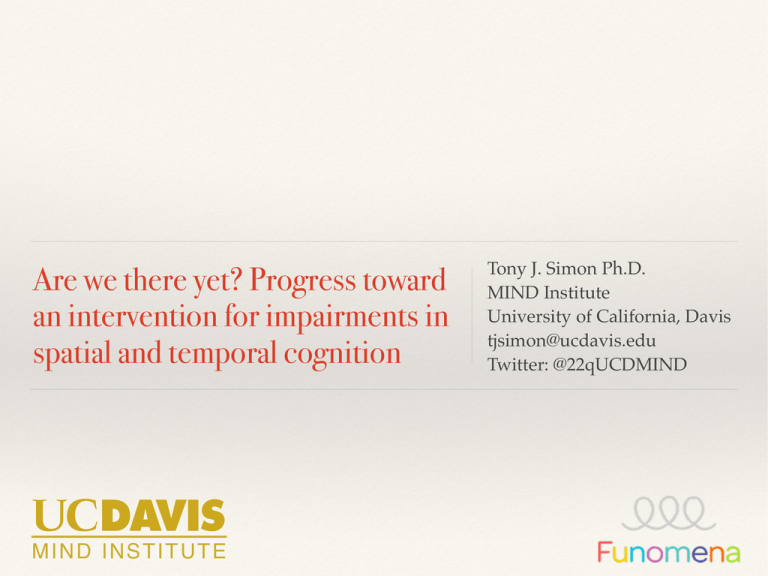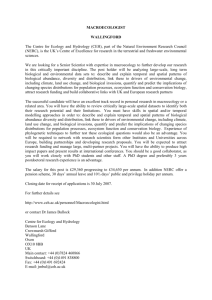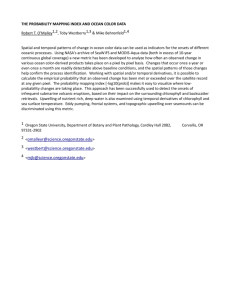Are we there yet? Progress toward an intervention for impairments in
advertisement

Are we there yet? Progress toward an intervention for impairments in spatial and temporal cognition MIND INSTITUTE Tony J. Simon Ph.D. MIND Institute University of California, Davis tjsimon@ucdavis.edu Twitter: @22qUCDMIND Bottom Line - At the Top! ❖ Goal: create a truly evidence-based digital neurotherapeutic intervention indicated for several disorder populations ❖ Planned Deliverables: scientifically-validated, marketready intervention & efficacy data ❖ Value: real health, not consumer/entertainment, product backed by expert clinician-scientist lab & data 2 What is the Problem? Some brains incompletely represent spatial/temporal information Characteristic of several neurodevelopmental disorders (NDDs): ~2 million US individuals (genetically defined NDDs) ❖ Chromosome 22q11.2 Deletion syndrome ❖ Fragile X syndrome and “premutation carriers” ❖ Turner syndrome ❖ Williams syndrome Commonly reported within phenotype of ❖ Non-Verbal Learning Disorder - less clearly defined disorder 3 What is the Problem? Some brains incompletely represent spatial/temporal information As a consequence of: ❖ Healthy aging of the neurocognitive system ❖ Brain injury or insult to parietal lobes/hippocampus ❖ Open heart surgery repairs for congenital heart defects ❖ or possibly, cardiac defect’s effect on brain development? 4 What Is The Solution? ❖ Fastbrain*, a “Digital Drug” neurotherapeutic ❖ Convergence of video game technology and two cognitive neuroscience evidence bases ❖ Targeted to specific neurocognitive functions ❖ Novel proprietary algorithms adaptively titrate neurocognitive stimulation solely to individual’s spatiotemporal ability *Patent pending 5 Spatial / Temporal Resolution in NDDs Fastbrain* Action Video Game Cognitive Effects What is the Problem? Fix your eyes on the cross on left. Count the bars on the right without moving eyes ❖ Brain incompletely represents spatial/temporal information ❖ ❖ as in photo from 4 megapixel vs. 16 megapixel camera Features of individual units merge into others = “crowding” ❖ Hypergranularity hypothesis for NDDs - Simon, 2008 ❖ loss of higher spatial and temporal frequency detection? 6 Primary Patient Group Indication: Impaired ability to mentally represent and process information about space and time. Leads to significant functional impairments in: ❖ ability to understand quantity, learn numbers, do math, make change, tell time, learn to drive, navigate …. ❖ creates lifelong stress and anxiety, reduces employment opportunities and earnings, if not independent living ❖ individuals become lifelong consumers of, not contributors to, societal resources 7 What is the Evidence? ❖ Children with 22q11.2DS much less able than typically developing peers to use attention to accurately detect objects beyond center of visual focus Each ring is 10º more “eccentric” from center What is the Evidence? ❖ When comparing a test magnitude to a fixed reference magnitude, children with 22q11.2DS require a significantly greater difference to perform as accurately as typically developing children. ❖ most TD children 80% correct at 93% vs. 87% ratio for children with 22q11.2DS, who show even greater impairment for time 9 What is the Evidence? Children with 22q11.2DS much less able than typically developing peers to accurately identify out-of-phase Flicker flickering target Phas Flicker Phase all groups 100 TD=39 22q=58 SCA=27 90 100 TD 22q SCA 90 80 Accuracy (%) 80 Accuracy (%) ❖ 70 70 60 60 50 50 40 2 4 6 Hz 8 10 40 P difficulty , 0.003) and, expected, this emerged numbers above them of asprocessing a difference second only target that for comes 200–500 subitizing range of NVGPs. Errorfirst bars one. denoteSecond s.e.m. (*Pis,the 0.05,cost **P , after the onset of the of 0.01). switchin tasks between the first and second target (from identification detection); unlike the attentional blinkover per the se, this effect mo enhanced allocation of spatial attention visual field,is even pronounced when the targets are temporally adjacent and th locations, intwo VGPs. Figure 2 Enumeration performance. When asked to report the number of squares briefly untrained as the time between targetsthat increases. Th flashed, VGPs were able to apprehend more items at once than were NVGPs (4.9 versus decreases The threeslowly experiments described sothe fartwo indicated video-ga attentional bottleneck is not specific to vision but rather 3.3). Overall, VGPs were significantly more accurate than NVGPs (78% versus 65%, playing enhances the capacity of visual attention and itsappea spa 21,23,24 . Thus, by using an identification/detection attention amodal P , 0.003) and, as expected, this difference only emerged for numbers above the distribution. We next examined the temporal characteristics blink attention task, we could test whether aft subitizing range of NVGPs. Error bars denote s.e.m. (*P , 0.05, **P , 0.01). visual and asked whether the the enhanced pressure tocapacities act rapidly video-game not only applied to purely visualgames, bottlene several visual training items, which is inherent to amost action al but also generalized to an amodal one. enhanced allocation of spatial attention over the visual field, even at untrained locations, in VGPs. The three experiments described so far indicated that video-game playing enhances the capacity of visual attention and its spatial distribution. We next examined the temporal characteristics of visual attention and asked whether the pressure to act rapidly on several visual items, which is inherent to most action games, alters What Is The Solution? ❖ Fastbrain is a digital neurotherapeutic ❖ Uniquely translates action video gaming “active compound” into treatment ❖ Many studies show enhanced spatial/ temporal resolution in serious action gamers (VGP) and trained non-gamers ❖ No such change results from non action game types (e.g. Tetris) 11 Figure 3 Measure of attention over space. a, Sequence of displays in the useful fie & Bavelier. Nature, 2003(triangle within c view task. Participants indicatedGreen the spoke on which the small target Figure 4 Measure of attention over time. a, Attentional blink task. Blackaffords letters an were appeared. By presenting the target at different eccentricities, this task Digital Neurotherapeutics - Better Targeted? ❖ Medications alter levels of target across entire brain ❖ Targets need instead to be specific circuits & functions ❖ Cannot train whole brain ❖ Most “brain training” creates non-transferrable practice Digital vs Pharma Neurotherapeutics ❖ Behavior change is target outcome, possible with digital alone ❖ Pharma alone may well be only half the intervention ❖ ❖ e.g. failed trials of FXS drugs like mGluR inhibitors ❖ not solely due to differential responders ❖ “what fires together wires together” won’t happen without targeted behavioral intervention Better outcome measured derivable from source paradigms 13 Why Not Off-The-Shelf Games? ❖ Many AVGs not great for cognitively impaired kids ❖ Commercial game algorithms respond to many factors ❖ ❖ Instead, convert AVG active compound to health product ❖ ❖ adaptivity not targeted to spatiotemporal ability disguised as game with commercial-level production values to ensure motivation & compliance Must be “medicine that children want to take”! 14 Fastbrain Functional Prototype ❖ Met our criteria for a scalable prototype ❖ Filed patent for proprietary algorithms ❖ Completed basic play testing/focus grouping ❖ ❖ played by 2 kids (7 & 8 years) from target populations ❖ both challenged but showed progress ❖ very motivated to play more Now cacheing data with IRB approval & iterating design 15 Considerable work put into decisions on optimal appropriate platform and input device to best translate science and accommodate target populations So, Does Fastbrain Work? ❖ Current prototype only Spatial Extent intended as proof of concept ❖ We limited the “range” & accelerated the adaptation Space Space 6 year-old impaired child Young adult unimpaired “gamer” ❖ ❖ Yet, prototype is sensitive to competence & generates Temporal Rate change in the impaired! Shows the algorithms can achieve their stated goals! Time Time Does Fastbrain Induce Change? ❖ To try to extend training, we changed “consistency” parameter requires 14 of 20 correct for FOV change (from 7 of 10) AB returned 4 months later ❖ ❖ ❖ FB20 games 1 & 2 improvement slower, asymptotes similarly, increased duration ❖ possible enhanced initial ability? Does achieve longer play (i.e. training) time Spatial Extent Temporal Rate What’s Next? •Pilot efficacy trial - “unfunded” project underway • Implement functionality for larger trials/experiments •Will require significant investment of resources • License IP to existing entity & develop in partnership • create start-up, raise funds, hire staff …… 19 Thank you for your time! MIND INSTITUTE What’s The Expected Exit? A. Initiate start-up, raise $$, develop full Fastbrain product B. License IP to existing entity & develop in partnership ❖ “Brain health” company seeking new/more evidencebased neurotherapeutics ❖ Akili, Lumosity, LearningRx, HappyNeuron, Posit 21




